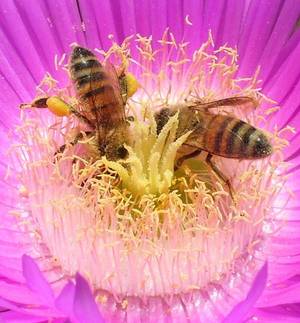A paper in Current Biology by University of California, San Diego,  scientist James Nieh reveals that bees encountering hostility use a stop signal to deter their fellow foragers from befalling the same fate they just did.
scientist James Nieh reveals that bees encountering hostility use a stop signal to deter their fellow foragers from befalling the same fate they just did.
Nieh made the discovery by watching the behaviour of bees returning to their hive after being attacked by rival colony members during a foraging flight. If the recently-mugged bee spotted another individual using its waggle dance to recruit other workers to forage in the same potentially dangerous location, it would unleash the stop signal on that dancer.
This consists of a head butt during which the bee vibrates its body 380 times per second for about one tenth of a second, altering the other bee to the danger. The number of times the stop signal was used by an individual was also proportional to the level of perceived danger, the team found.
Bees that faced significant aggression upped their rate of warnings 40-fold, whilst those whose legs were mechanically pinched to simulate a bite from another bee delivered 88-fold more warnings.
This clever system ensures that the response the colony makes to a threat is proportional to the level of risk and also protects other individuals.
"This signal is directed at bees who are recruiting for the dangerous food location and decreases their recruitment," says Nieh. "Thus, fewer nest-mates go to the dangerous food site. This is important because an individual experiences danger and stops recruiting, but the stop signal enables her to 'warn' nest mates too. Theend result is that the colony will reduce or cease recruitment to the dangerous food patch in proportion to the danger."
- Previous Why are tranquilisers addictive?
- Next What do mosquitoes smell?









Comments
Add a comment